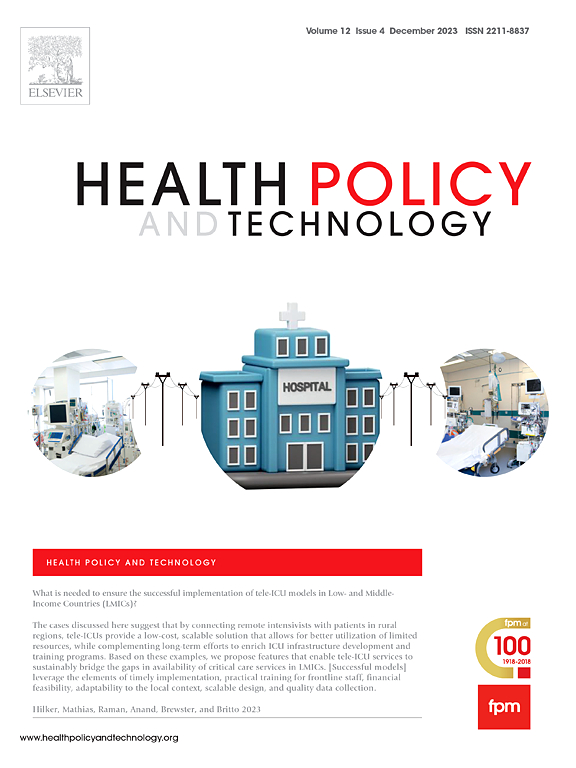Contributing factors of sentinel events involving medical devices: A cross-sectional retrospective human factors analysis
IF 3.7
3区 医学
Q1 HEALTH POLICY & SERVICES
引用次数: 0
Abstract
Background and objective
Although most medical device applications in hospitals are safe and effective, in a small number of cases devices are involved in patient safety events causing serious unintended patient harm. These so-called sentinel events are thoroughly investigated by hospitals, with detailed event descriptions filed in reports. Studying these reports may help fill the knowledge gap on the latent contributing factors of sentinel events involving medical devices. This study aims to identify the contributing factors of sentinel events involving medical devices and how these factors lead to unintended patient harm.
Design
A cross-sectional retrospective analysis of 20 sentinel event reports involving medical devices from Dutch general hospitals, using a human factors approach and specific classification system for medical device related events.
Results
A total of 105 contributing factors were identified. For most events, factors relating to the operator (e.g., flaws in setting up and checking devices before use), device (e.g., design issues), infrastructure (e.g., poor environmental ergonomics) and patient (e.g., complicating anatomy) mutually contributed and interacted. Jointly these factors triggered events causing unintended patient harm.
Conclusions
In-depth analysis of reports of sentinel events using a human factors approach, showed the underlying patterns of interacting contributing factors leading to unintended patient harm. Sentinel events involving medical devices are triggered by an interplay of factors related to the operator, device, infrastructure, and patient. To prevent future patient harm, an integral approach addressing all these elements is needed.
Public Interest Summary
Medical devices can be involved in events leading to unintended patient harm in hospitals. We know little about the underlying factors contributing to such events. Therefore, 20 reports of events involving a medical device that led to serious patient harm were analysed in depth. In most events, the patient harm was triggered by factors relating to the operator of the device, the device itself, the organisation and environment in which the device was applied, and the patient to whom the device was applied. Jointly, these factors prompted the events and led to patient harm. The insights from this study can be used to further improve the safe application of medical devices in hospitals.
涉及医疗器械的哨点事件的影响因素:横断面回顾性人为因素分析
背景和目的虽然大多数医疗器械在医院的应用是安全有效的,但在少数情况下,设备涉及患者安全事件,造成严重的意外患者伤害。医院对这些所谓的哨点事件进行了彻底调查,并在报告中详细描述了这些事件。研究这些报告可能有助于填补关于涉及医疗器械的前哨事件的潜在影响因素的知识空白。本研究旨在确定涉及医疗器械的哨点事件的影响因素,以及这些因素如何导致意外的患者伤害。采用人为因素方法和医疗器械相关事件的特定分类系统,对荷兰综合医院涉及医疗器械的20例哨点事件报告进行横断面回顾性分析。结果共鉴定出105个影响因素。对于大多数事件,与操作人员(例如,在使用前设置和检查设备的缺陷),设备(例如,设计问题),基础设施(例如,恶劣的环境人体工程学)和患者(例如,复杂的解剖结构)相关的因素相互影响和相互作用。这些因素共同引发了对患者造成意外伤害的事件。结论使用人为因素方法对哨点事件报告进行深入分析,显示了导致患者意外伤害的因素相互作用的潜在模式。涉及医疗设备的前哨事件是由操作员、设备、基础设施和患者相关因素的相互作用触发的。为了防止未来对患者造成伤害,需要采取一种解决所有这些因素的综合方法。医疗器械可能涉及导致医院患者意外伤害的事件。我们对导致这些事件的潜在因素知之甚少。因此,深入分析了20份涉及医疗装置导致患者严重伤害的事件报告。在大多数情况下,患者伤害是由与设备操作人员、设备本身、设备应用的组织和环境以及设备应用的患者相关的因素引发的。这些因素共同促成了这些事件,并导致了患者的伤害。本研究的见解可用于进一步改善医院医疗器械的安全应用。
本文章由计算机程序翻译,如有差异,请以英文原文为准。
求助全文
约1分钟内获得全文
求助全文
来源期刊

Health Policy and Technology
Medicine-Health Policy
CiteScore
9.20
自引率
3.30%
发文量
78
审稿时长
88 days
期刊介绍:
Health Policy and Technology (HPT), is the official journal of the Fellowship of Postgraduate Medicine (FPM), a cross-disciplinary journal, which focuses on past, present and future health policy and the role of technology in clinical and non-clinical national and international health environments.
HPT provides a further excellent way for the FPM to continue to make important national and international contributions to development of policy and practice within medicine and related disciplines. The aim of HPT is to publish relevant, timely and accessible articles and commentaries to support policy-makers, health professionals, health technology providers, patient groups and academia interested in health policy and technology.
Topics covered by HPT will include:
- Health technology, including drug discovery, diagnostics, medicines, devices, therapeutic delivery and eHealth systems
- Cross-national comparisons on health policy using evidence-based approaches
- National studies on health policy to determine the outcomes of technology-driven initiatives
- Cross-border eHealth including health tourism
- The digital divide in mobility, access and affordability of healthcare
- Health technology assessment (HTA) methods and tools for evaluating the effectiveness of clinical and non-clinical health technologies
- Health and eHealth indicators and benchmarks (measure/metrics) for understanding the adoption and diffusion of health technologies
- Health and eHealth models and frameworks to support policy-makers and other stakeholders in decision-making
- Stakeholder engagement with health technologies (clinical and patient/citizen buy-in)
- Regulation and health economics
 求助内容:
求助内容: 应助结果提醒方式:
应助结果提醒方式:


